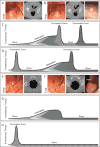New insights into the earliest stages of colorectal tumorigenesis
- PMID: 28503955
- PMCID: PMC5859121
- DOI: 10.1080/17474124.2017.1330150
New insights into the earliest stages of colorectal tumorigenesis
Abstract
Tumors in the large intestine have been postulated to arise via a stepwise accumulation of mutations, a process that takes up to 20 years. Recent advances in lineage tracing and DNA sequencing, however, are revealing new evolutionary models that better explain the vast amount of heterogeneity observed within and across colorectal tumors. Areas covered: A review of the literature supporting a novel model of colorectal tumor evolution was conducted. The following commentary examines the basic science and clinical evidence supporting a modified view of tumor initiation and progression in the colon. Expert commentary: The proposed 'cancer punctuated equilibrium' model of tumor evolution better explains the variability seen within and across polyps of the colon and rectum. Small colorectal polyps (6-9mm) followed longitudinally by interval imaging with CT colonography have been reported to have multiple fates: some growing, some remaining static in size, and others regressing in size over time. This new model allows for this variability in growth behavior and supports the hypothesis that some tumors can be 'born to be bad' as originally postulated by Sottoriva and colleagues, with very early molecular events impacting tumor fitness and growth behavior in the later stages of the disease process.
Keywords: Big Bang model; CT colonography; colorectal cancer; punctuated equilibrium; tumor heterogeneity; tumorigenesis.
Conflict of interest statement
The authors have no relevant affiliations or financial involvement with any organization or entity with a financial interest in or financial conflict with the subject matter or materials discussed in the manuscript. This includes employment, consultancies, honoraria, stock ownership or options, expert testimony, grants or patents received or pending, or royalties.
Figures

References
-
- Vogelstein B, Fearon ER, Hamilton SR, et al. Genetic alterations during colorectal-tumor development. N Engl J Med. 1988;319:525–32. This seminal paper first described the tumor progression in the colon and rectum to occur via the stepwise accumulation of mutations in tumor suppressor genes and oncogenes. The diagram in which specific mutations were coupled to discrete stages became known as the “Vogelgram”. - PubMed
-
- Muto T, Bussey HJ, Morson BC. The evolution of cancer of the colon and rectum. Cancer. 1975;36:2251–70. - PubMed
-
- Miyoshi Y, Nagase H, Ando H, Horii A, Ichii S, Nakatsuru S, Aoki T, Miki Y, Mori T, Nakamura Y. Somatic mutations of the APC gene in colorectal tumors: mutation cluster region in the APC gene. Hum Mol Genet. 1992;1:229–33. - PubMed
-
- Nagase H, Nakamura Y. Mutations of the APC (adenomatous polyposis coli) gene. Hum Mutat. 1993;2:425–34. - PubMed
-
- Pickhardt PJ, Kim DH, Pooler BD, et al. Assessment of volumetric growth rates of small colorectal polyps with CT colonography: a longitudinal study of natural history. Lancet Oncol. 2013;14:711–20. This paper was the first to demonstrate that colorectal polyps in humans could have different fates. Some grew, some remained static, some regressed, and some even completely resolved. - PMC - PubMed
Publication types
MeSH terms
Substances
Grants and funding
LinkOut - more resources
Full Text Sources
Other Literature Sources
Medical
Research Materials
